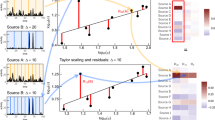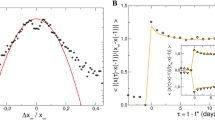Abstract
Negative feedback leading to self-regulatory behaviour is an important phenomenon that affects time-series fluctuations in a range of systems and is critical in forecasting and management, particularly when complex dynamics are possible. Smethurst and Williams1 argue that the lengths of waiting-lists to see hospital consultants are self-regulating, on the grounds that the relative changes in the size of waiting-lists follow a power law, with large changes being relatively rare compared with small ones. Here we show that similar power laws can also be obtained from unregulated, random time series. The existence of a power law that governs fluctuations in time series is not sufficient to prove the existence of self-regulatory behaviour, and we argue that a more sophisticated analysis is required.
Similar content being viewed by others
Main
Figure 1a shows a power law derived from the data of Smethurst and Williams1. In their analysis, the rarity of large changes in the length of waiting-lists is used as evidence for negative feedback: people are more likely to join short rather than long queues, thereby buffering changes. Figure 1b reveals a similar relationship in the number of people waiting at the bar of a public house. The similarity of the plots for the two systems could be taken as evidence of a general power law governing the behaviour of queues. However, the data in Fig. 1a, b have not been tested against a null model, and it is not clear what pattern would be expected in a system with no self-regulatory behaviour.
a–c, Frequency distributions of relative changes in numbers (measured as (Nt + 1 − Nt)/Nt, where N is the number at current time t, or at one time period later, t + 1) plotted on a double-logarithmic scale. a, Frequency distribution of the extent of length changes in hospital waiting-lists for consecutive months (different symbols signify different consultants); data from ref. 1. The frequency of large variations declines according to a power law (solid line, regression). b, Similar analysis of changes in the number of people at the bar of the Butcher's Arms public house in Headington, near Oxford. c, Similar analysis of data from discrete-time random walks. Results of random walks of length 300 time units are shown; different symbols denote separate replicates. Inset, asymptotic distribution, from a series of length 30,000 time units. These random walks (brownian motion) assume changes in numbers that are normally distributed (with zero mean); at any time t, the change in number is independent of the number at that time. Hence, this system shows no self-regulatory behaviour — in terms of a waiting-list or queue, this would imply that people join or leave at random, with no regard for the number of other people waiting. In a–c, dashed lines have a slope of − 2, the expected value for a log-normal distribution of relative fluctuations.
The appropriate null model for a system with no regulation is a random walk (brownian motion). If data are following a random walk (that is, if the time series is unregulated), the frequency distribution of relative changes will be expected to show power-law-like behaviour. This is because even in unregulated time series, relatively large fluctuations would be expected to be less common than relatively small ones.
To illustrate this point, Fig. 1c shows the results of applying Smethurst and Williams' analysis to randomly generated data from brownian-motion time series. These time series yield frequency distributions of relative changes that are strikingly similar to the plots in Fig. 1a, b, and which have a power-law slope that is indistinguishable from −2. This indicates that Smethurst and Williams' data are entirely consistent with models in which self-regulation does not occur. The existence of this power-law relationship cannot therefore be used to infer the operation of self-regulatory mechanisms.
Providing evidence for such negative feedback is difficult, as shown, for example, by the problems of detecting density-dependence in ecology2,3. We suggest three approaches to the problem of detecting negative feedback in hospital waiting-lists, on the basis of approaches taken by pop-ulation ecologists. One is to adjust queue lengths experimentally and examine the responses2. The second is to plot the rate of change in queue length against the length of the queue, although this is subject to statistical problems2,3. The third is to use behaviour-based population modelling4 to determine the range of trade-offs made by individuals — for example, specific trade-offs can be quantified between the expected waiting time for treatment and the probability of choosing private treatment. Knowledge of such responses could then be applied to reducing waiting times. By contrast, relationships of the type shown in Fig. 1 constitute a poor method of characterizing and forecasting such systems.
References
Smethurst, D. P. & Williams, H. C. Nature 410, 652–653 (2001).
Bulmer, M. Biometrics 31, 901–911 (1975).
Rothery, P. in Insect Population (eds Dempster, J. P. & McLean, I. F. G.) 32–68 (Chapman & Hall, London, 1998).
Sutherland, W. J. From Individual Behaviour to Population Ecology (Oxford Univ. Press, Oxford, 1996).
Author information
Authors and Affiliations
Corresponding author
Rights and permissions
About this article
Cite this article
Freckleton, R., Sutherland, W. Do power laws imply self-regulation?. Nature 413, 382 (2001). https://doi.org/10.1038/35096646
Issue Date:
DOI: https://doi.org/10.1038/35096646
This article is cited by
-
25 Years of Self-organized Criticality: Concepts and Controversies
Space Science Reviews (2016)
-
Anomalous Fluctuations in the Motion of Partitioning Objects
Journal of Statistical Physics (2014)
Comments
By submitting a comment you agree to abide by our Terms and Community Guidelines. If you find something abusive or that does not comply with our terms or guidelines please flag it as inappropriate.




